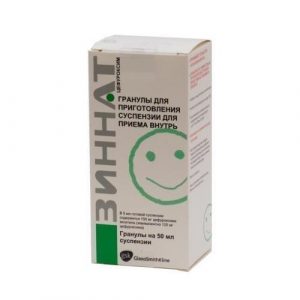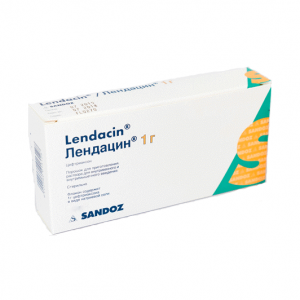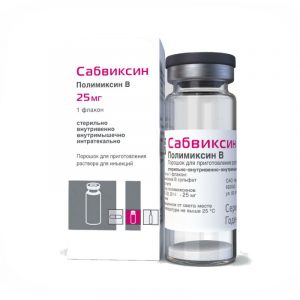Description
Latin name
CEFTRIAXONE
Release form
Powder for the preparation of a solution for intravenous and intramuscular administration crystalline, almost white or yellowish.
Pharmacological action
antibiotic, cephalosporin
Contraindications
– Hypersensitivity to ceftriaxone and other cephalosporins, penicillins, carbapenems.
With caution, the drug is prescribed for UC, for impaired liver and kidney function, for enteritis and colitis, associated with the use of antibacterial drugs for premature and newborn babies with hyperbilirubinemia.
Use during pregnancy and lactation
Use during pregnancy is only possible in cases where the intended benefits to the mother outweigh the potential risk to the fetus, as ceftriaxone crosses the placental barrier.
If you need to use the drug during lactation, you should decide on the termination of breastfeeding, because ceftriaxone is excreted in breast milk.
Special instructions
With simultaneous severe renal and hepatic failure, in patients undergoing hemodialysis, the concentration of the drug in plasma should be regularly determined.
With prolonged treatment, it is necessary to regularly monitor the picture of peripheral blood, indicators of the functional state of the liver and kidneys.
In rare cases, with ultrasound of the gallbladder, blackouts are noted that disappear after stopping treatment (even if this phenomenon is accompanied by pain in the right hypochondrium, it is recommended that antibiotic administration and symptomatic treatment be continued).
During treatment, you should not drink alcohol, since disulfiram-like effects are possible (facial flushing, cramping in the abdomen and stomach, nausea, vomiting, headache, decreased blood pressure, tachycardia, shortness of breath).
Despite a detailed medical history, which is also the rule for other cephalosporin antibiotics, the possibility of anaphylactic shock, which requires immediate treatment, cannot be ruled out – first inject epinephrine iv, then GCS.
In vitro studies have shown which, like other cephalosporin antibiotics, ceftriaxone is able to displace bilirubin associated with serum albumin. Therefore, in newborns with hyperbilirubinemia, and especially in premature infants, the use of ceftriaxone requires even more caution.
Elderly and debilitated patients may need vitamin K.
Store the prepared solution at room temperature for no more than 6 hours or in a refrigerator at a temperature of 2-8 ° C for no more than 24 hours.
Composition
1 vial.
ceftriaxone (in the form of sodium salt) 1 g
Dosage and administration
The drug is administered in / m or / in.
Adults and children over 12 years of age are prescribed 1-2 g 1 time / day (every 24 hours). In severe cases or infections, the causative agents of which have only moderate sensitivity to ceftriaxone, the daily dose can be increased to 4 g.
Newborns (up to 2 weeks) are prescribed 20-50 mg / kg body weight 1 time / day. The daily dose should not exceed 50 mg / kg body weight. When determining the dose, no distinction should be made between full-term and premature infants.
Infants and young children (from 15 days to 12 years) are prescribed 20-80 mg / kg of body weight 1 time / day.
For children with body weight> 50 kg are prescribed doses intended for adults.
Doses of 50 mg / kg or more for iv administration should be administered dropwise for at least 30 minutes.
Patients in old age should be given the usual dose for adults, not adjusted for age.
The duration of treatment depends on the course of the disease. The introduction of ceftriaxone should be continued by patients for at least 48-72 hours after normalizing the temperature and confirming the eradication of the pathogen.
With bacterial meningitis in infants and young children, growth begins with a dose of 100 mg / kg (but not more than 4 g) 1 time / day. After identifying the pathogen and determining its sensitivity, the dose can be accordingly reduced.
With meningococcal meningitis, the best results were achieved with a treatment duration of 4 days, with meningitis, caused by Haemophilus influenzae – 6 days, Streptococcus pneumoniae – 7 days.
With Lyme borreliosis: adults and children over 12 years of age are prescribed 50 mg / kg once a day for 14 days, the maximum daily dose is 2 g.
For gonorrhea (caused by strains that form and do not form penicillinase) – once intramuscularly dose of 250 mg.
In order to prevent postoperative infections, depending on the degree of infectious risk, the drug is administered in a dose of 1-2 g once for 30-90 minutes before surgery.
In operations on the colon and rectum, the simultaneous (but separate) administration of ceftriaxone and one of the 5-nitroimidazoles, for example, ornidazole, is effective.
In patients with impaired renal function, there is no need to reduce the dose if liver function remains normal. In cases of severe preterminal renal failure with CC <10 ml / min, the daily dose should not exceed 2 g. In patients with impaired liver function, there is no need to reduce the dose if renal function remains normal. With a combination of severe renal and hepatic insufficiency, the plasma concentration of ceftriaxone should be regularly determined and its dose adjusted if necessary. Patients on dialysis do not need additional drug administration after dialysis. However, it is necessary to control the concentration of ceftriaxone in serum in order to timely dose adjustment, since the rate of excretion of the drug in these patients may decrease. Rules for the preparation and administration of solutions For v / m administration of The contents of the vial (1 g) are dissolved in 3.6 ml of water for injection. After preparation, about 250 mg of ceftriaxone is contained in 1 ml of solution. If necessary, you can use a more diluted solution. As with other i / m injections, ceftriaxone is injected into a relatively large muscle (gluteal) test suction to avoid unintentional insertion into a blood vessel. It is recommended to inject no more than 1 g of the drug into one muscle. To reduce pain with i / m injections, the drug should be administered with a 1% lidocaine solution. You can not enter a solution of lidocaine iv. For iv administration of The contents of the vial (1 g) are dissolved in 9.6 ml of water for injection. After preparation, 1 ml of the solution contains about 100 mg of ceftriaxone. The solution is administered slowly over 2-4 minutes. For iv infusion Dissolve 2 g of Ceftriaxone in 40 ml of sterile water for injection or one of the infusion solutions, not containing calcium (0.9% sodium chloride solution, 2.5%, 5% or 10% dextrose solution, 5% levulose solution, 6% dextran solution in dextrose). The solution is administered for 30 minutes. Side effects Allergic reactions: urticaria, chills or fever, rash, itching rarely – bronchospasm, eosinophilia, exudative erythema multiforme (including Stevens-Johnson syndrome), serum sickness, anaphylactic shock. From the digestive system: nausea, vomiting, diarrhea or constipation, flatulence, abdominal pain, taste disorder, stomatitis, glossitis, pseudomembranous enterocolitis, impaired liver function (increased activity of hepatic transaminases, less commonly alkaline phosphatase or bilirubin, cholestic jaundice), pseud bladder (sludge syndrome), dysbiosis. From the hemopoietic system: anemia, leukopenia, leukocytosis, neutropenia, granulocytopenia, lymphopenia, thrombocytosis, thrombocytopenia, hemolytic anemia, hypocoagulation, a decrease in the concentration of flame coagulation factors (II, VII, IX, X), prolongation of prothrombin time. From the urinary system: impaired renal function (azotemia, increased blood urea, hypercreatininemia, glucosuria, cylindruria, hematuria), oliguria, anuria. Local reactions: phlebitis, soreness along the vein, soreness and infiltration at the site of intramuscular injection. Other: headache, dizziness, nosebleeds, candidiasis, superinfection. Drug Interactions Ceftriaxone, suppressing the intestinal flora, interferes with the synthesis of vitamin K. With simultaneous administration with drugs that reduce platelet aggregation (NSAIDs, salicylates, sulfinpyrazone), the risk of bleeding increases. With simultaneous administration with anticoagulants, an increase in the effect of the latter is noted. With simultaneous administration with loop diuretics, the risk of developing nephrotoxicity increases. Ceftriaxone and aminoglycosides have synergies with many gram-negative bacteria. Incompatible with ethanol. Pharmaceutical Interactions Ceftriaxone solutions should not be mixed or administered simultaneously with other antimicrobial agents. Ceftriaxone should not be mixed with calcium-containing solutions. Overdose With an overdose, hemodialysis and peritoneal dialysis do not reduce the concentration of the drug. There is no specific antidote. Symptomatic overdose treatment. Storage Conditions List B. The product should be stored out of reach of children, in a dry, dark place at a temperature not exceeding 25 ° C. Shelf life 3 years Active ingredient Ceftriaxone Terms of dispatch from pharmacies Prescription from Ruzfarm, Russia



